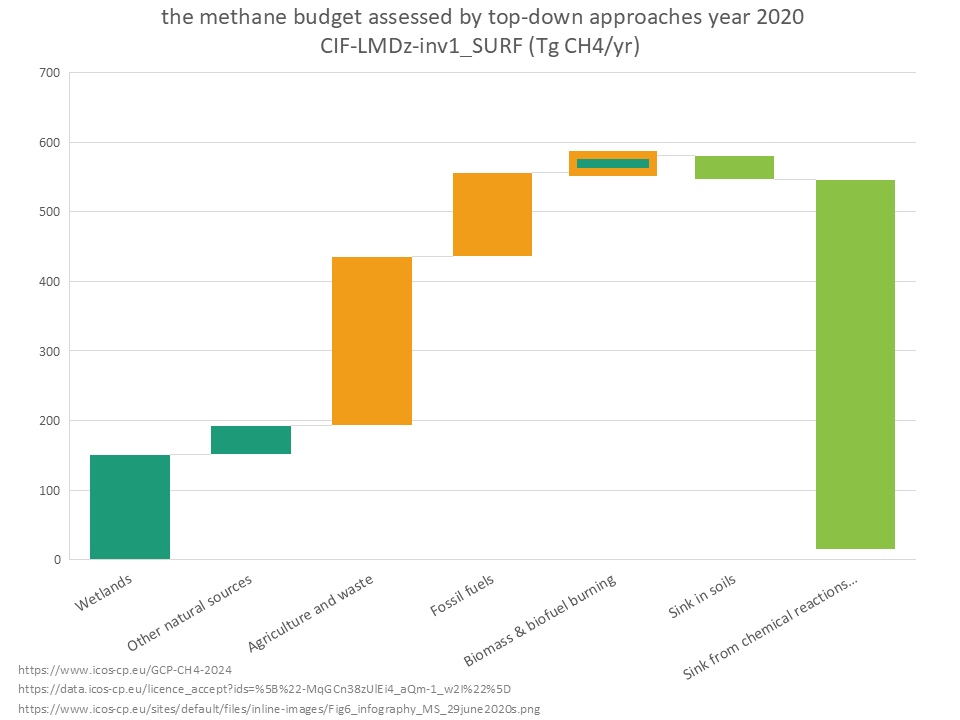Pick Up
1259. Global Methane Budget

1259. Global Methane Budget
Global methane (CH4) is the second most important anthropogenic greenhouse gas in terms of climate forcing, after carbon dioxide (CO2). CH4 emissions and atmospheric concentrations have been increasing since 2007, after a temporary decrease. Two major challenges in quantifying the causes of the observed atmospheric concentration increase stem from the diverse and geographically overlapping CH4 sources and the uncertainties in the magnitude and temporal evolution of CH4 destruction by the short-lived and highly variable hydroxyl radical (OH).
Understanding and quantifying the CH4 budget is important for assessing realistic pathways to mitigate climate change. To address these challenges, a multidisciplinary consortium of scientists is regularly refining, synthesizing, and updating the global methane budget and stimulating new research on the methane cycle.
The 2025 edition estimates global CH4 emissions for the decade 2010-2019 to be 575 Tg/yr (range 553-586) based on a top-down analysis. Of this amount, 369 Tg/yr (about 65%) is attributable to direct anthropogenic sources such as fossil fuels, agriculture, waste, and anthropogenic biomass burning. For the period 2000-2009, the total emissions were slightly lower than for 2010-2019, by 32 Tg/yr. The emission rate in 2020 was the highest in the 2000-2020 period, reaching 608 Tg/yr, 12% higher than the average emissions in the 2000s.
For 2010-2019, emissions from agriculture and waste were estimated at 228 Tg CH4/yr and 211 Tg CH4/yr for the top-down and bottom-up approaches, respectively. The bottom-up value accounts for 60% of total direct anthropogenic emissions. Emissions from agriculture amount to 144 Tg CH4/yr, accounting for 40% of direct anthropogenic emissions, with the remainder coming from the fossil fuel sector (34%), waste (19%), biomass (5%), and biofuel (3%) combustion.
The agriculture and waste category includes CH4 emissions associated with livestock production (ruminant enteric fermentation and manure management), rice cultivation, landfills, and wastewater treatment. Of these activities, livestock farming is by far the largest CH4 source in most countries worldwide (112 Tg CH4/yr, about one-third of the total global anthropogenic emissions), followed by waste disposal (estimated average 69 Tg CH4/yr, about 19%), and rice cultivation (32 Tg CH4/yr, about 9%). Rice cultivation produces the largest amount of CH4 emissions in Asia, accounting for 30% to 50% of global emissions. A decrease in CH4 emissions from rice cultivation in recent decades has been identified in most inventories and is attributed to a decrease in rice cultivation area, changes in agricultural practices, and the northward shift of rice cultivation since the 1970s.
The paper provides recommendations for improving the CH4 budget, including the creation of a global high-resolution map of CH4-emitting saturated soils and flooded areas based on a classification of different emitting ecosystems, and improved source attribution using information from bottom-up inventories of anthropogenic super emitters (mainly the oil and gas sector, but also coal, agriculture, and landfills).
(Reference)
Marielle Saunois et al, Global Methane Budget 2000–2020, Earth System Science Data (2025).
https://essd.copernicus.org/articles/17/1873/2025/
Contributor: IIYAMA Miyuki, Information Program
